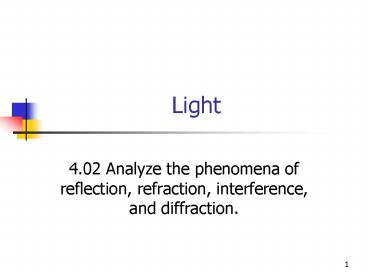Light PowerPoint PPT Presentation
1 / 12
Title: Light
1
Light
- 4.02 Analyze the phenomena of reflection,
refraction, interference, and diffraction.
2
Light
- The atom is the source of all forms of light,
whether visible or invisible. - Electrons produce small bundles of light energy
as they move back and forth within the energy
levels. - These bundles of light energy are called photons.
- Some light waves are visible some are not.
3
Light
- Speed of light is the same for all forms of
light 186,000 miles/sec or 300,000 Km/sec. - All waves are transverse waves however, there
are no moving molecules of a medium. - There are only moving photons of energy.
- The moving photons of energy generate electric
and magnetic fields therefore, light waves are
called electromagnetic waves.
4
Electromagnetic Spectrum
- The electromagnetic spectrum is the arrangement
of electromagnetic waves in order of their
wavelengths, and thus their frequencies. - They consists of Radio waves, Infrared waves,
Visible light, Ultraviolet light rays, X-rays,
and Gamma rays. - Moving from left to right across the chart,
wavelength decreases, which means that frequency
increases.
5
Radio Waves
- Include the following categories
- AM and FM radio.
- TV.
- Short wave radio.
- Radar.
- Microwave.
- Microwaves
- Are the highest frequency radio waves.
- Are used in radar.
6
The Human Eye
- The human eye can see only the visible light
section of the spectrum. - The visible light spectrum is located mid-way of
the spectrum. - Light enters the eye through the pupil The
amount of light that enters the eye is controlled
by the iris The cornea and the lens refract
light to focus it on the retina The brain
interprets the image.
7
On the Spectrum
- Radio wave has the longest wavelength, which
equals low energy. - Gamma rays have the shortest wavelength.
- Have the highest frequency if all the spectrum.
- Have very high energy and are dangerous to all
living things. - Can penetrate all materials except lead.
- Color is determined by wavelength.
8
Devices and Instruments
- A spectroscope is a device that enables us to see
the specific patterns of wavelengths emitted by
individual elements in the excited state it
accomplishes this by splitting light into its
spectrum and then analyzes it. - Lasers are instruments that amplifies light into
a narrow beam of one wavelength. - They are used to read the sound pattern on a
compact disc and to produce holograms. - Optical fibers are long, thin flexible fibers of
glass or plastic that transmit light.
9
Devices and Instruments
- A hologram is a three-dimensional picture made
from laser light. - The image formed by a camera is real, upside
down, and smaller than the object. - A refracting telescope uses lenses to focus and
magnify light . - A reflecting telescope uses mirrors to gather
light. - A microscope uses lenses to magnify extremely
small objects.
10
Reflection of Light
- Reflection is the bouncing back of light.
- The type of surface determines the kind of
reflection formed. - A regular reflection is the bouncing back of
light from a smooth, even surface. - A diffuse reflection is the bouncing back of
light from an uneven surface.
11
Reflection and Mirrors
- Three types of mirrors 1. Plane, 2. Concave, and
3. Convex. - Plane mirrors have perfectly flat surfaces.
- Concave mirrors are curved inward. )
- Convex mirrors are curved outward. (
12
Refraction of Light
- The bending of light due to a change in speed is
called refraction. - Every medium has a specific index of refraction.
- The index of refraction is the comparison of the
speed of light in air with the speed of light in
a certain material. - A convex lens converges light rays.
- A concave lens diverges light rays.

